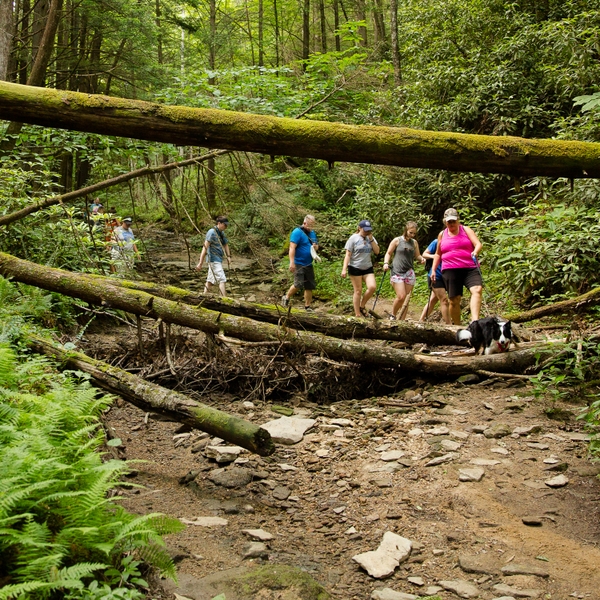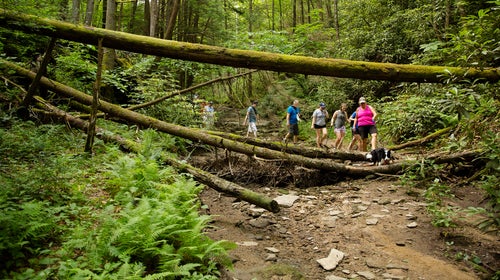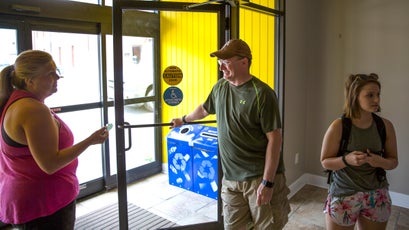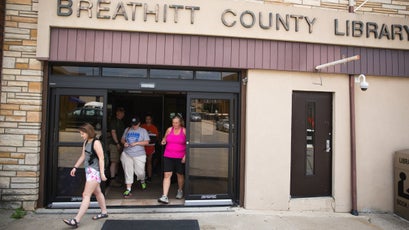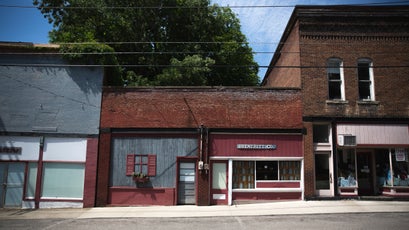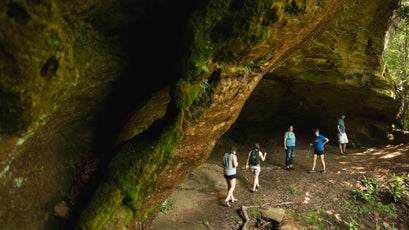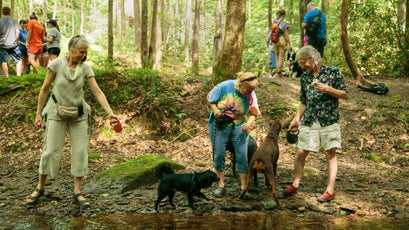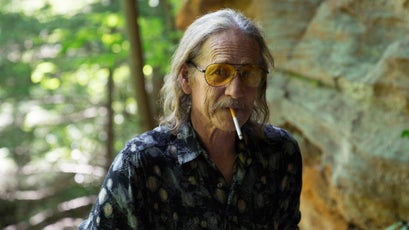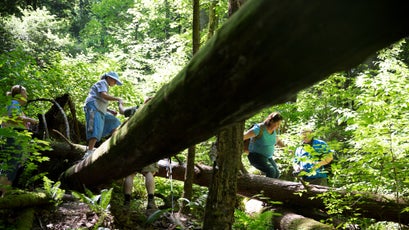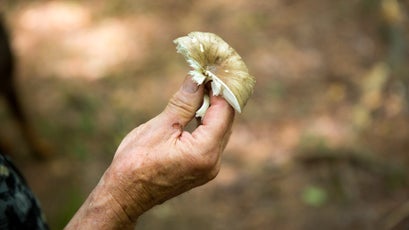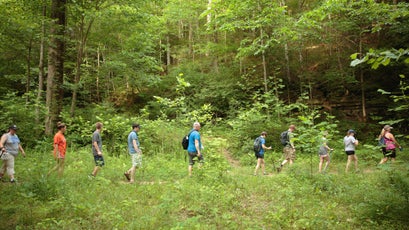How Hiking Could Help Change the Fate of Rural Appalachia
Rural Appalachia is the unhealthiest place in the country by almost any metric. Steve Bowling, a 45-year-old library director in Kentucky, has a simple remedy: nature walks.
New perk: Easily find new routes and hidden gems, upcoming running events, and more near you. Your weekly Local Running Newsletter has everything you need to lace up! .
One Sunday every month, always after church, the Breathitt County Hiking Club meets outside the public library in Jackson, Kentucky to caravan to a trailhead. On an afternoon in early June, Stephen Bowling, the library’s executive director, eagerly waited inside the glass doors for the group to arrive for their trip to Copperas Creek Trail in Red River Gorge, about 40 minutes away.
As people trickled in, Bowling happily fielded questions about the hike. “How long is it again?” asked Phyllis Light, a 74-year-old wearing clean white Skechers. Her friend Doris Newton, an outspoken middle-aged woman who works at the local hardware store, hopped out of the car with her dog. “What’s the difficulty level?” Newton asked as her husband took a drag of his cigarette and laughed about how he wore swim shoes instead of hiking boots.
“We’re told constantly that we’re the least-healthy people, we are this, we are that, and people don’t feel empowered to change that.”
Bowling, a 45-year-old father with a toothy grin, has been hosting these monthly field trips since the beginning of the year. An avid backpacker, he has hiked hundreds of miles on the Appalachian Trail and elsewhere in the Southeast, an experience he’s determined to share with others. Bowling’s new hiking club, sponsored by the Breathitt County Public Library, is his latest effort to get people in this rural town out into nature. The trips usually attract around 20 people. “A little bit here, a little bit there. We’ll get them moving,” he says. Most of Bowling’s patrons lack any experience in the outdoors and don’t fancy themselves hikers, bikers, or fitness enthusiasts. But Bowling doesn’t judge; he’s just happy they’ve showed up.
That’s because rural Appalachia is the unhealthiest place in the country by almost any metric: lowest life expectancy and education levels; highest rates of poverty, unemployment, and physical inactivity; and severe lack of access to health care and health food, according to the annual . Bowling believes he can begin to improve this situation by introducing his peers to the outdoors, so he started his monthly hikes to put a small dent in the growing public health crisis and alleviate the sense of fatalism in his community. “It’s a depressed area economically, but also emotionally and physiologically,” Bowling says. “We’re told constantly that we’re the least-healthy people, we are this, we are that, and people don’t feel empowered to change that. Some people aren’t willing, and some people aren’t able.”
After a short drive on that spring day, the 14-person group arrived at a trailhead deep in the Daniel Boone National Forest. The overgrown brush was still damp from rain earlier that week, leaving the 90-degree Kentucky air muggy. All together, they excitedly started up the trail, asking about poison ivy, pointing out tree species they’d discussed at a recent local event, and staring in awe at the forest. “Wow, this is just amazing,” said 47-year-old Julie Stamper as she put her cigarette out and stuffed the butt into her backpack. “I’ve never been to a place like this before.”
Isolated geographically and culturally by the rolling Appalachian Mountains, Appalachia is a prime example of the rural-urban wellness divide. The region has dealt with climbing poverty rates for decades. Today, 25 percent of people in Eastern Kentucky and 20 percent of those in Appalachian Virginia live below the poverty line, according to the . Out of the top ten counties in the United States with the largest declines in life expectancy, . One is the former coal-mining county of Breathitt, which has a population of nearly 14,000 people—98 percent white, most over 40 years old. Nearly half the population is obese, about a third smoke, and a third are physically inactive. The unemployment rate is almost 12 percent.
Many people, like Bowling, believe more access to public lands and increased opportunities for physical activity can help address some of these problems. Although outdoor recreation isn't a cure-all for poverty, it’s part of the story, says Laura Dwyer-Lindgren, researcher at the Institute for Health Metrics and Evaluation at the University of Washington. concluded that public lands could be used as one element in a comprehensive strategy to address public health issues in rural areas. Other communities in the Southeast are responding to such findings by increasing local engagement efforts to get people outside, says Jerry Spegman, a community coach for County Health Rankings and Roadmaps. “Even if a town doesn’t land on a hiking club as its solution, there are widespread efforts in other states in the region […] to get better at working with people on the ground at this,” he says.
Ironically, rural communities tend to be cut off from public land, leaving them with the fewest choices for outdoor activity and exercise. “Most people consider rural areas safer or closer to public lands, outdoor recreation, and parks,” says Mark Holmes, director of the North Carolina Rural Health Research and Policy Analysis Center, “but in reality, they can be very isolating.” Most Southeastern states have less than 5 percent federal public land. In Kentucky, less than 4 percent of land is federally owned, and there are only a few state parks, most of them a half-day’s drive from Breathitt. Only of Breathitt county residents live ; meanwhile, of New York county residents and of San Francisco county residents have such access to a park within a half-mile or a recreational facility within just one mile.
This means that the majority of possible outdoor adventure spaces are under private control, typically owned by coal mining companies or landowning conglomerates rather than purveyors of public trail systems. In the rare instances where a private owner does choose to create trails, locals say that they’re often designed for ATVs and not easily accessible to hikers or mountain bikers. In many rural Southern communities like Appalachia and the Mississippi Delta, there are few safe, well-marked walking or biking trails. If there is a local gym, it’s usually small and has limited hours. Instead, “many people rely on the local high school to keep its running track unlocked and open to the public,” Holmes says.
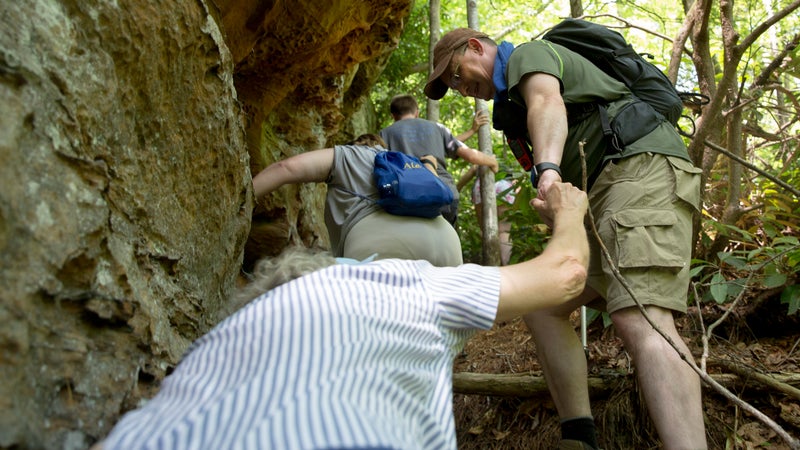
Given the staggering wellness outcomes emerging from this part of the country, the rural-urban health divide has risen to the forefront of national conversation. All eyes are on how eastern Kentucky and Appalachia are working to address these issues, says Dee Davis, founder of the in Whitesburg, Kentucky. “All of a sudden, they’re beginning to look more at health and disease to find different sets of linkages,” he says. “I imagine that in five years, we’ll have a much better picture than what we have now.” How these types of local programs fare and how public lands prove to help the situation could inform the conversations of policymakers moving forward.
Bowling’s no longer just the leader of a local group; he’s also becoming a figurehead for a small but fervent public health movement. He answers questions about hiking every time he’s out in the community, whether he’s shopping at Walmart or at church on Sunday mornings. “People didn’t know how to be active or get on our trails because they’re ignorant to what’s healthy or uninterested in finding out,” says Breathitt resident Masja Ott. But with Bowling as a familiar friend and resource, excitement about the hikes—and about health in general—is growing around town.
“I admire how much Steve is trying to help people get healthier. It’s so good if people are willing to take advantage of it,” Light says. Those who have attended only one hike, like Julie Stamper, are keen to grow the movement. “I was so tired when I got home that day, but I’ve already told my entire family that we’re going to go on more hikes,” she says. Last month, ten new people saw the hiking photos on the and visited Red River Gorge on their own. “We get more traction out of [word of mouth] than all of the papers and pamphlets you could hand out in a year,” Bowling says.
The community health needle may be moving slowly, but it’s not at a standstill. Rural Southern regions are looking to places like North Carolina and Colorado—which have effectively tapped into their outdoor recreation economy—to figure out ways to make public lands profitable and accessible. In July, legislation will go into effect to create the , a group run by community members from around the state that will develop, maintain, monitor, and promote local trails. State Representative , who introduced the bill, says his goal is to connect 17 counties through a trail system. “Some of the most beautiful places are hidden away,” Fugate says. “We haven’t done a good enough job of promoting and taking care of ourselves here.”
In the meantime, Bowling will continue to herd a small group of strangers from around the county and lead them on his favorite hidden hikes. “The great success of this program is opening people up to a world they didn’t know was there,” he says. His isn’t the one-and-done solution to all the public health woes facing Breathitt, Bowling says. “But if we solve one problem at a time, or help someone get in shape one person at a time, we’ve completed our goal.”
